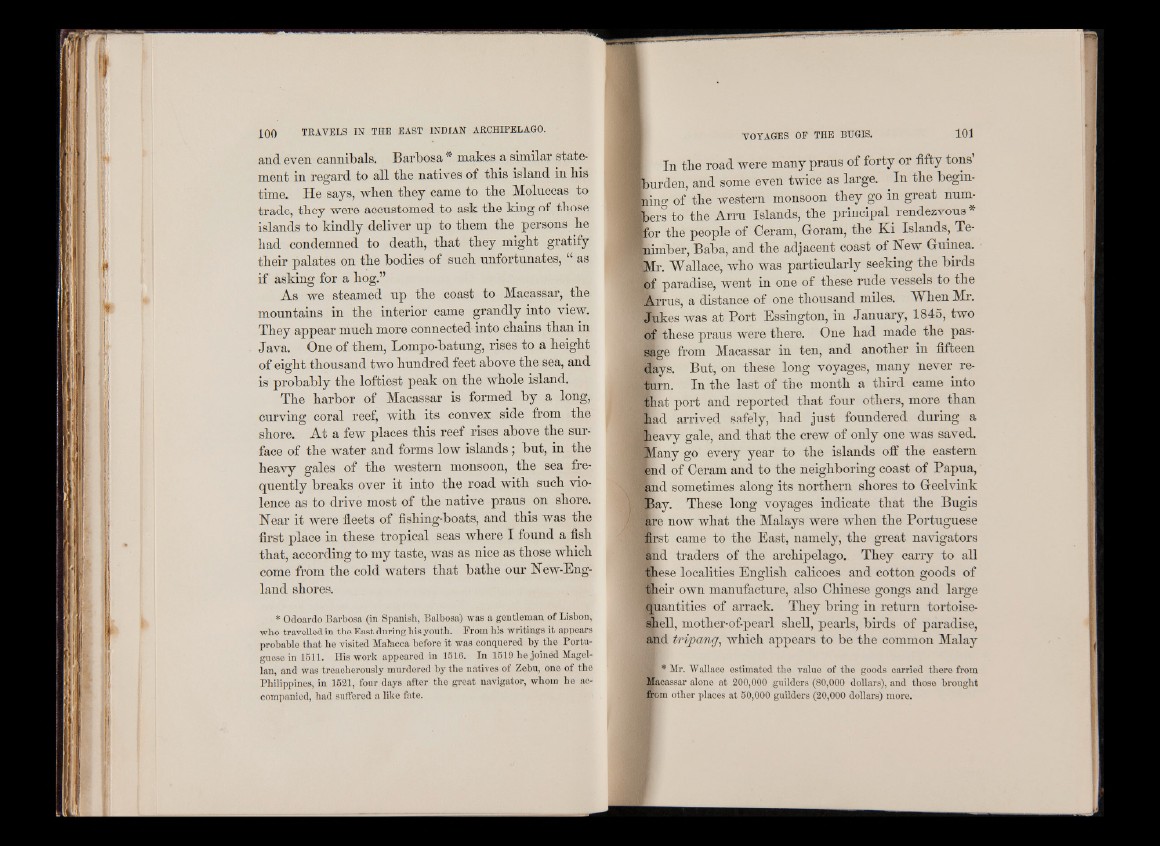
and even cannibals. Barbosa * makes a similar statement
in regard to all the natives of this island in his
time. He says, when they came to the Moluccas to
trade, they were accustomed to ask the king of those
islands to kindly deliver up to them the persons he
Lad condemned to death, that they might gratify
their palates on the bodies of such unfortunates, “ as
if asking for a hog.”
As we steamed up the coast to Macassar, the
mountains in the interior came grandly into view.
They appear much more connected into chains than in
Java. One of them, Lompo-batung, rises to a height
of eight thousand two hundred feet above the sea, and
is probably the loftiest peak on the whole island.
The harbor of Macassar is formed by a long,
curving coral reef, with its convex side from the
shore. At a few places this reef rises above the surface
of the water and forms low islands; but, in the
heavy gales of the western monsoon, the sea frequently
breaks over it into the road with such violence
as to drive most of the native praus on shore.
Near it were fleets of fishing-boats, and this was the
first place in these tropical seas where I found a fish
that, according to my taste, was as nice as those which
come from the cold waters that bathe our New-England
shores.
* Odoardo Barbosa (in Spanish, Balbosa) was a gentleman of Lisbon,
who travelled in the East during his youth. From his writings it appears
probable that he visited Malacca before it was conquered by the Portuguese
in 1511. His work appeared in 1516. In 1519 he joined Magellan,
and was treacherously murdered by the natives of Zebu, one of the
Philippines, in 1521, four days after the great navigator, whom he accompanied,
had suffered a like fate.
VOYAGES OF THE BUGIS. 101
In the road were many praus of forty or fifty tons’
[burden, and some even twice as large. ^ In the beginning
of the western monsoon they go in great numbers
to the Arru Islands, the p r i n c i p a l ^ rendezvous *
por the people of Ceram, Goram, the Ki Islands, Te-
fnimber, Baba, and the adjacent coast of New Guinea.
■Mr. Wallace, who was particularly seeking the birds
of paradise, went in one of these rude vessels to the
farras, a distance of one thousand miles. When Mr.
Jukes was at Port Essington, in January, 1845, two
of these praus were there. One had made the passage
from Macassar in ten, and another in fifteen
days. But, on these long voyages, many never re-
Ifurn. In the last of the month a third came into
that port and reported that four others, more than
had arrived safely, had just foundered during a
heavy gale, and that the crew of only one was saved.
M any go every year to the islands off the eastern
end of Ceram and to the neighboring coast of Papua,
;%nd sometimes along its northern shores to Geelvink
Bay. These long voyages indicate that the Bugis
áre now what the Malays were when the Portuguese
first came to the East, namely, the great navigators
and traders of the archipelago. They carry to all
these localities English calicoes and cotton goods of
their own manufacture, also Chinese gongs and large
quantities of arrack. They bring in return tortoiseshell,
mother-of-pearl shell, pearls, birds of paradise,
and t/ripang, which appears to be the common Malay
■ * Mr. Wallace estimated tbe value of tbe goods carried there from
Macassar alone at 200,000 guilders (80,000 dollars), and those brought
from other places at 50,000 guilders (20,000 dollars) more.